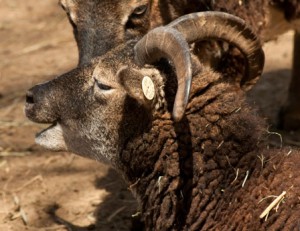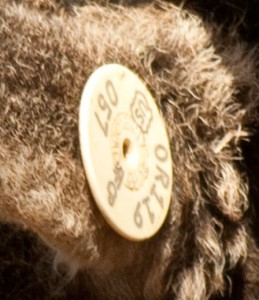To tag or not to tag, that is the question for Soay sheep owners
Answer? Yes.
End of post? Not quite.
In the world of pedigrees and registrations, identification is everything. Paperwork listing a Soay sheep’s name and parentage is a great start and required for registration, but in the final analysis, ear tags (or tatoos or imbedded chips) are the only way to positively identify an animal, by linking its tag number to its paperwork. If an owner has only one or two sheep, or only raises Soay for meat, ear tags are less important and many people would say unnecessary. But the value of a Soay sheep to be registered or sold as breeding stock comes largely from its authenticity — is it really a Soay sheep? — and pedigree. Without some form of positive identification, that value pretty much goes out the window. Using tags even with a very small flock is good practice so the procedures are routine as the flock grows.
Here are a few hypothetical examples of why we believe ear tags are an essential component of accurate and ethical breeding and sales.
Mary’s mix-up. Mary buys four Soay adult ewes from Jim. Three of them are brown with nice horns; the fourth is scurred with a white spot on the top of her head. The paperwork consists of a bill of sale listing the four ewes’ names, birth dates, and parents. The ewes do not have ear tags. Although Mary has no prior experience with sheep or with fleece colors, she’s confident she will be able to tell her ewes apart after she leaves Jim’s farm. Within a couple of weeks, she gets swamped at work and asks her teenage kids to do chores for her. About a month later when her work schedule eases, she heads back out to check on the ewes. To her dismay, the three brown ones look just alike and worse yet, she cannot remember which one had the white spot on her head. Oh yes, and Jim has been transferred overseas and doesn’t do email, so even if he could describe enough distinctive traits to help her figure out who’s who, he is unavailable.
Tim’s lost tape. Tim is excited when his first three Soay ewes present him with two singles and a pair of twins, all rams (well okay, he is disappointed about no ewes, but it’s just an example), all brown. For the first three or four weeks, the lambs stick close to their own mothers and since Tim has spent a lot of time walking amongst his ewes, he is confident about which lamb is which. Then the lambs become less dependent on their moms and wander off during the day to explore the pastures. Still no problem, they come back to nurse when their moms call. Tim weans the lambs at about 12 weeks, but he has decided not to bother with baby ear tags and he has not had time to figure out how the scrapie identification program works. No problem; he simply tapes his ram lambs’ horns in different colors until he has time to get adult scrapie tags. The ram lambs look quite smart and rakish in their tape, and after a day of bawling for their mothers, they settle in to enjoy the freedom to munch around in the pastures without having to come home to mother for supper. All goes as planned and in fact, the weaned ram lambs get along so well that Tim doesn’t have to do much with them for a few weeks other than be sure they have enough water and their mineral feeder is full. But Tim’s heart sank when he came out one Saturday morning and found that the ram lambs had figured out make-believe headbutting and the color-coded tape for three of the boys was strewn about the pasture. One ram could still be identified from the list of ewes and the color of tape on his horn. The other three were no longer identifiable.
Jill’s juggling act. Jill prides herself on the uniform look of her flock. For several years she has bred her American Soay for polling and for light brown fleece. She chooses to let her ewes lamb in the field, more like what took place on St. Kilda for generations. She read online that all she needs is a pair of binoculars (boy, do I wish I had been the first one to think of that line!). Although she elected not to disturb the natural scene in the field by going out and putting baby ear tags in each lamb’s ear, she is not worried about a lamb mix-up because the mothers have ID tags in their left ears. These assumptions and adages are usually true, and lambing generally works out this way. But then one morning Jill put down her binoculars and went out to have a closer look — she heard more than the normal amount of animal noise overnight. To her consternation, two ewes (either in the field or perhaps they came into the barn for shelter) were spooked by something and caught their ears in a fence or on a door or a latch or a mineral feeder and their ear tags tore off. Not only can Jill no longer tell the ewes apart, but now their lambs are also without identification.
None of these three examples matches precisely the circumstances we’ve heard about, but each is close enough for discomfort. Far too often we have commiserated with buyers who realized too late that the paperwork they were given does not match the tags on their new Soay sheep and perhaps does not match the animal’s physical appearance (color, spotting), or worse yet, the sheep have no tags at all or have lost them. Sellers are almost always available and cooperative to resolve the confusion in these cases, but sad to say it occasionally happens that a seller is not willing to help the buyer once the sheep have left the seller’s farm, or the seller simply disappears when his or her flock has been sold to unsuspecting buyers.
Stuff happens. Those of us who breed British Soay need to be able to report accurately on the identity and parentage of our lambs in order to participate fairly in the RBST registration process. All of us who sell Soay sheep — British or American — need to be able to look our buyers in the eye and tell them with confidence which animal is which. Ear tags, and especially the use of both baby and adult tags, provide such assurance. If the adult tag is lost, for example (and the official scrapie tags do break apart on occasion), the remaining baby tag provides a road map so the adult tag can be replaced.
One way to get tags for your adult Soay sheep is to participate in one of the US (or Canadian) scrapie programs. The USDA provides free adult ear tags, and participating in either government’s program will allow you and your buyers to legitimately ship interstate. The USDA tags come with your farm’s premises ID number — an abbreviation for your state followed by a 3- or 4-digit number (ours is OR119). A second number located on the other side of the tag is the unique number for each sheep (001, 002, 003, and so forth).
Here’s our ewe Wendron with her scrapie tag — OR119 057.
And here’s a closeup of her tag, to give you an idea of how the numbering is placed on this round scrapie tag:
Sheep sold to Canadian buyers must have USDA tags. Veterinarians signing interstate transportation papers need to list the animals by name and identification number, and we cannot imagine an interstate transporter accepting sheep without ear tags or tatoos. The last thing you want to have happen is to get part way home with your new Soay sheep and be turned back at the border of your home state because you lack proper documentation for your new animals.
If for some reason you choose not to participate in either the “voluntary” or “mandatory” scrapie program, you can get adult-size tags from your local feed store and put your own tag numbers on with the marking pen that should come with the tags. Any kind of numbered tag is better than none!
Using adult tags solves most identity problems, unless one of two things happens: lambs get mixed up before their ears are big enough to hold the heavier adult tags, or the adult animal loses its tag. Between the number of instances in which our own sheep lost their adult ear tags, and the experiences we know about from other owners, we became convinced early on to use baby ear tags and also to leave them in the lambs’ ears even after they get their permanent adult tags at about 12 weeks. The baby ear tags are a failsafe measure, to be sure we know which lamb is which so we can register them. Using the little tags protects us from the awkward situation of realizing we can no longer identify a poor little sheep whose identification has gone astray.
Lamb tags small enough for Soay sheep are not commonly sold in the U.S., but fortunately there is at least one good source that is easy to find and use. I’ll talk about it in my next post.
For now …

